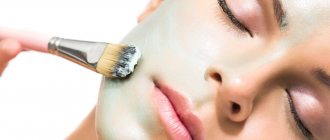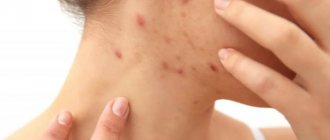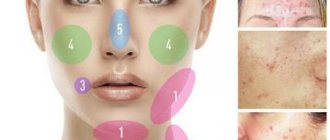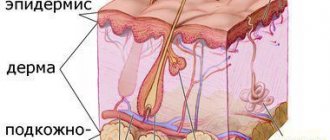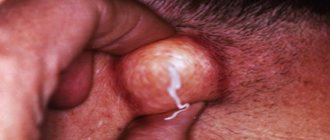Why do acne appear on my chest*?
There may be several reasons for the appearance of acne* on the chest [4, 50, 29]:
- Hormonal imbalance. The presence of gynecological diseases, puberty in adolescents, and certain periods of the menstrual cycle cause a surge of hormones that provoke rashes.
- Poor nutrition. Although the influence of nutritional factors on the formation of acne does not have reliable evidence, there is an opinion that some products can indirectly provoke an exacerbation of acne. In particular, these include milk, cakes, sweets, fatty, salty foods.
- Wearing tight, uncomfortable clothing. Rashes may occur on the chest due to wearing synthetic clothing, which does not allow the skin to breathe and increases sweating. Rashes can also appear due to constant rubbing or squeezing.
- Cosmetics with comedogenic ingredients. Its use leads to clogged pores and the development of acne.
Acne occurs for various reasons - heredity, mechanical stress, long-term use of certain medications, stress [4, 50, 29]. Before treating acne* on the chest, you must be examined by a specialist.
How to treat acne
As you understood from the previous block, there are many reasons for the appearance of acne. You can treat the external manifestations of acne as much as you like, but until the true cause of their appearance is found, all measures taken will only bring a temporary effect. Therefore, it is important to consult a doctor promptly, even at the first stage of the disease.
But you should understand that no doctor can just look at you, immediately name the cause and prescribe treatment. It is necessary to conduct a diagnosis to identify the true cause and select a treatment regimen that will be effective.
Be patient. It is not possible to cure acne in a couple of weeks. Therapy of several months is required to completely eliminate the cause of the inflammatory process and reduce the risk of relapse. Don't give up treatment halfway!
How to remove and prevent acne* on the chest?
Although there are no means to prevent acne, there are several useful recommendations that, if followed, will reduce the risk of developing rashes in the chest area:
- After training and physical activity, you should immediately take a shower. Rashes can be triggered by excessive sweating.
- Do not use aggressive cosmetics in the décolleté area. The skin here is thin and requires a delicate approach.
- Don't neglect special care. Most girls ignore the décolleté area when taking care of their skin, but in vain. There are special products for this part of the body that take into account its characteristics.
- If acne* appears on your chest, reconsider your diet. Eliminate fast carbohydrates from it, give up fast food, carbonated drinks, coffee, and alcohol.
- Give preference to clothes made from natural fabrics, make sure that things do not rub or squeeze your skin.
- Try to reduce the number of stressful situations. Under the influence of cortisol, the sebaceous glands can secrete more sebum.
Remember that acne is a chronic disease. It cannot be cured once and for all, but you can reduce the risk of its exacerbation.
Miliaria - symptoms and treatment
If any rashes appear on your child’s skin, you should consult a pediatrician or dermatologist.
To make a correct diagnosis, you need to ask the patient. If a child is sick, ask the parents questions. Then carefully examine the affected skin and evaluate the nature and location of the rash.
History taking
When collecting anamnesis, you need to find out:
- When did the rash appear and what preceded it? Miliaria rashes appear a few days after exposure to provoking factors.
- Has the patient been sick before? Miliaria profuse usually occurs in patients with a history of multiple episodes of miliaria rubra.
Inspection
With crystalline prickly heat, transparent bubbles 1-2 mm in size appear, which are filled with liquid and look like a drop of water. Since the most superficial layer of the epidermis (stratum corneum) is affected, the vesicles have a very thin wall, so they rupture easily. The rash is usually located on the upper torso, neck and head.
Miliaria rubra is characterized by larger, erythematous papules and red blisters. In newborns, the groin, axilla and neck are often affected. In adults, the rash appears in areas where clothing rubs against the skin [12].
With deep heat rash, the doctor sees hard, flesh-colored rashes. In adults, the rash most often appears on the torso, but the arms and legs can also be affected.
If the elements rise above the skin, then miliaria is called pustular , which may indicate the addition of a bacterial infection.
Miliaria is diagnosed based on typical clinical manifestations. Laboratory and instrumental methods are rarely used.
Laboratory diagnostics
Laboratory tests are generally not performed because they are often ineffective. a cytological examination can be performed - a laboratory assessment of cell morphology. In this case, inflammatory cells are detected.
Gram staining can help identify pathogenic bacteria such as staphylococci [1].
Instrumental diagnostics
People with dark skin may be prescribed dermatoscopy - an examination of the skin using a special device. In this case, the rash appears as large white balls with darker halos surrounding them.
There is evidence of the use of optical coherence tomography for the diagnosis of miliaria profuse. Optical coherence tomography is a non-contact diagnostic study that allows you to obtain information about the morphological state of healthy and pathologically altered skin. To obtain tissue images using OCT, near-infrared light is used to illuminate the area of skin being examined. In miliaria, high-resolution OCT helps to detect the depth of ductal damage and the likely location of blockage [17].
If there is doubt about the diagnosis, a skin puncture biopsy . With crystalline prickly heat, blisters are found under the stratum corneum of the resulting area of skin. Histology of miliaria rubra shows accumulation of fluid (sweat) between the cells of the stratum spinosum. You can also see blisters filled with sweat and inflammation around the sweat gland ducts. Miliaria profunda differs from red heat by further rupture of the eccrine ducts and more significant inflammation.
Differential diagnosis
Miliaria should be distinguished from other diseases that occur with skin rashes: chickenpox, scarlet fever, measles, herpes rash type 6 (sudden exanthema), herpes zoster, urticaria, fungal infections of the skin, acne or toxic erythema of the newborn, atopic dermatitis, insect bites and etc.
Allergic rashes
A local rash caused by allergens quickly becomes generalized. The first pimples are small, red. They itch and flake unbearably. Further internal or external contact with irritants transforms acne into the form of blisters, oozing, and ulcers.
In large areas, local temperatures rise. The initial stage of an allergic rash goes away on its own if contact with the allergen is interrupted.
Measles rash
Measles viruses can cause acne on the shoulders of women. The body responds to their invasion with an inflammatory-allergic reaction in the form of dilated blood vessels and fragmented edema. Bright pink, cavityless papules of an asymmetrical shape appear, slightly swollen, with a flat top.
Pimples on the shoulders can be caused by measles. Here are instructions on how to identify the disease and what is recommended when it is detected
They are interspersed with red traces of small hemorrhages from damaged vessels. Pinpoint measles rashes expand, merging with each other. They spread from the forehead across the face, shoulders, covering the entire body and the mucous membrane of the palate in 3 days. The active phase lasts up to 4 days.
This is followed by a period of pigmentation - the swelling goes away, the redness is replaced by brown spots that are very flaky. After 7-10 days, the skin returns to normal.
Sunbathing for rashes
Natural ultraviolet light is useful in the form of dosed irradiation - light tanning in the morning and afternoon.
Sunbathing should be combined with sea bathing - salt disinfects, dries, and heals acne.
Acne treatment by a doctor
For acne, the therapist prescribes tests that can identify a secondary infection - whether there are bacteria or protozoa in the inflamed sebaceous glands. This is done by scraping the skin. Depending on its result, you may be prescribed:
- antibacterial therapy (taking antibiotic tablets) – if bacteria are found (usually staphylococci or streptococci are found);
- antiprotozoal therapy (in the form of tablets and gels) – in the case of the presence of opportunistic Demodex mites.
In the future, after eliminating the secondary infection, the doctor will prescribe you a course of restorative therapy for the body:
- probiotics to normalize intestinal microflora;
- drugs to restore liver function.
If normalization of hormone levels does not occur on its own after the end of puberty, hormonal medications may also be prescribed.
Acne treatment
For external use, an infusion of aloe vera is prepared. The lower mature leaves are first kept in the refrigerator for 10 days, then ground. 1 part puree should be mixed with 5 parts water. After an hour, boil for 3 minutes. Wipe the acne with the expressed infusion 3-4 times a day.
Fresh parsley juice has an anti-inflammatory, healing effect, and restores skin structure. Grind the parsley and squeeze through cheesecloth. Apply the juice to acne 2 times in each of the 25 days of treatment.
Nettle extract regulates the functioning of the sebaceous glands , soothes inflammation, and clears blackheads. 2 tbsp. l. leave for 2 hours in 400 ml of boiling water. Drink half a glass 4 times daily before meals. You can wipe acne with the same infusion several times.
Seborrhea and keratosis
Acne-type acne on the back and chest occurs against the background of oily seborrhea, when the skin becomes porous, shiny, and the mouths of the hair follicles are blocked by comedones - fat plugs. With inflammation, purulent blisters often appear. Acne takes a long time to heal. It is very important to determine its root cause and focus the primary treatment on it.
Acne on a woman’s shoulders, the causes of which lie in seborrheic keratosis, appears in the initial phase as a flat, rough spot. It slowly gains a bright or dark color and rises due to the growth of a layer of keratinized cells. Keratomas are classified as neoplasms.
They grow on the shoulders, neck, back alone or in groups, 1-10 cm in size, in the form of a mole or protruding horn. The structure of flat formations is similar to cracks.
Seborrheic keratosis formations have not been fully studied and are dangerous for malignant degeneration.


